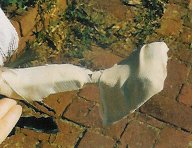|
WILD BIRD RESCUE
Broken legs are an injury frequently encountered by the Pretoria-based bird rehabilitation centre Wings in Need. Long-legged birds, such as plovers, dikkops, egrets and herons are particularly prone to this sort of injury. Fortunately broken legs heal very well if quickly and properly treated, and the birds are usually very successfully rehabilitated and released. Broken legs are usually easy to recognize. Symptoms include:
· The leg being bent at an unnatural angle.
· The tip of the bone protruding through the skin (compound fracture).
· A large lump or swelling on the bone.
· The bird absolutely refuses to use the leg.
Immediate treatment is essential if the leg is to heal properly. Ideally, immobilize the limb, stabilize the bird and get help immediately. Telephone your local rehabilitation centre for advice. To stabilize the bird, apply first aid:
· Carefully restrain the bird in a towel. Take care not to complicate the break by bending the leg where broken!
· The bird is likely to be dehydrated. Mix Emergency Oral Electrolytes made up of 900 millimeters warm water with three teaspoons of sugar and one teaspoon of salt. Administer lukewarm. Gently restrain the bird in a towel. Supply the electrolytes drop by drop to the side of the closed and tilted beak. The beak is not waterproof and the liquid will dribble into the bird’s throat without choking it.
· Place the bird wrapped in ravel-free towel in a ventilated (small round air holes) cardboard box, not a wire cage. If the bird feels colder than blood temperature, provde a direct gentle heat source. Don’t overheat.
Should you be unable to take the bird to a rehabilitation centre, involve your local vet in helping, as a treatment will probably involve, without being limited to:
· Setting the broken bones. This involves fixing a lightweight splint with tape. Make sure that the leg is straight and that the ends of the bone are clean and in contact with each other.
· If the position of the toes is affected due to nerve or other damage, use a ‘snowshoe’ splint to hold them in a natural position. (see photo) Cortisone and Vitamin B complex will work wonders for a nerve injury.
· Antibiotic treatment to prevent infection. This is essential in case of a compound fracture.
· The bone should heal within three weeks. Removal of the splint is followed by long term convalescence and rehabilitation.
A Hadeda showing the ‘snowshoe’ splint: With common sense prevailing, the toes are set in the natural position (at 90 degrees angle with leg) on a rounded piece of foamalite or plastic, cut to size, with micropore or something like masking tape strapped over and around. A bit of cotton wool can be placed directly under the toes for cushioning.

By Gordon M Duncan & Wings in Need
Animal Talk July 1999
< Back
|













